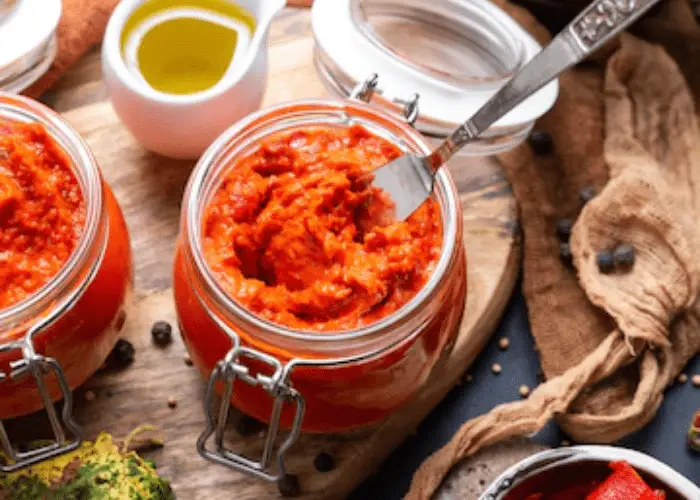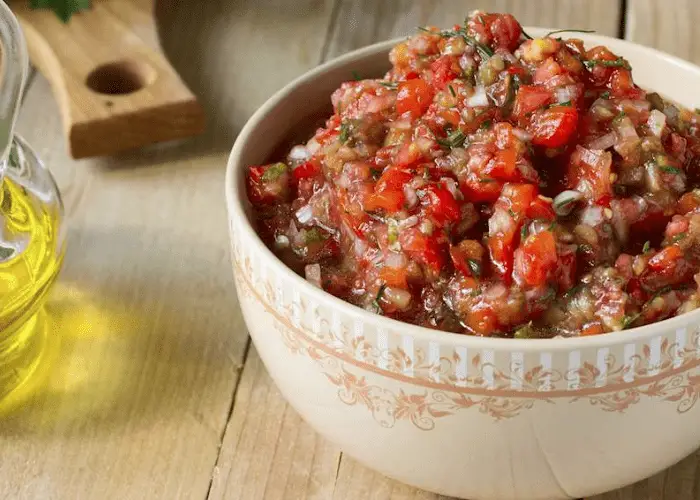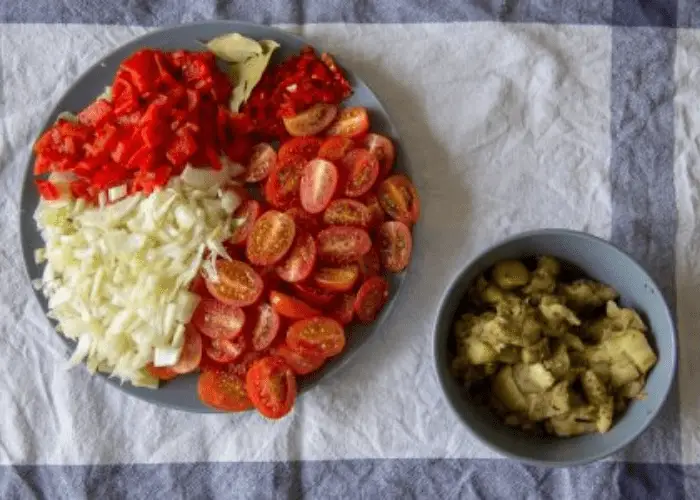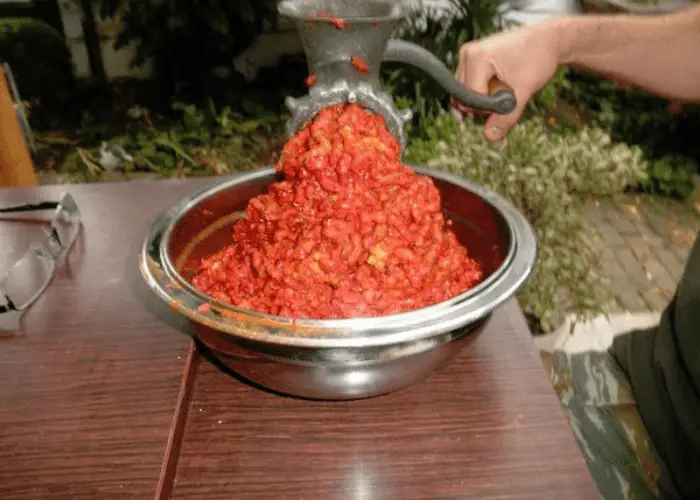Ajvar is a luxurious spread that will make you fall in love with red peppers.
Pronounced eye-var, this spread is a Balkan treasure. Several countries lay claim to it, such as Bosnia, Serbia, Macedonia, and Romania.
This decadent spread goes by many names, but the Serbian version got its name from the Turkish word havyar, which means caviar. It was first created to preserve the peppers during winter.
If you look up Serbian national food, ajvar is at the top of all lists, and it’s been the country’s favorite food for centuries. Today, I’ll talk about everything there’s to know about ajvar, its variations, including the best homemade recipe, so you can enjoy some ajvar yourself.
What is Ajvar?
Ajvar is a kind of condiment that’s made with roasted red peppers and eggplant. They are mashed, then simmered for hours to get a rich spread.
In Balkan countries, ajvar is a way to use red peppers from the summer’s harvest. It’s traditionally made when red peppers are ripe, from the middle of September to early October. The ajvar recipe is a carefully guarded family secret, and it’s passed from one generation to the next, so the new generations can make ajvar the same way their grandmothers did.
Ajvar has two common variations: a mild version, made with sweet bell peppers, and a spicy version that’s a combination of sweet bell peppers and spicy chiles. You can even go heavy on the vinegar if you prefer a tangy sauce.
Ajvar can also have different textures, from a paste to a mash with noticeable chunks in it. Essentially, there’s no right or wrong with ajvar. Each family makes it according to their preferences, and all ajvar is good ajvar.
Ajvar making is a family and friends event, as whole bushels of red peppers are roasted, peeled, and mashed. Think large quantities of 10 to 30 kg of peppers (352 to 1059 ounces). The goal is to make enough ajvar to last through the whole winter, so it’s an all-hands-on-deck operation.
Ajvar Different Variations Throughout the Balkans
Ajvar comes in different variations throughout the Balkan region. Some of the most common you can find are:
Ljutenica
Found in Bulgaria, it’s made with pepper, carrot, tomato, black pepper, garlic, onion, eggplant, oil, salt, and sugar.
Pindjur
Found in Bosnia and Herzegovina, Serbia, Macedonia, and Bulgaria. Although Serbians consider pindjur and ajvar to be two different spreads, it’s often used as a synonym to ajvar. It’s made with eggplant, tomatoes, onion, garlic, pepper, oil, salt, and sugar.
Kyopolou
Found in Bulgaria and Turkey. It’s mostly made of eggplants and garlic, and then baked bell peppers, tomatoes, parsley, and onions can be added.
Zacuscă
Found in Romania. It’s made with sauteed onions, eggplant, roasted bell peppers, and tomato paste. Other vegetables can be added, such as mushrooms and carrots.
What to Eat With Ajvar
You can eat ajvar with literally anything. Go basic, and spread some ajvar over a slice of bread with some cheese. Or, use it as a sauce for your favorite pasta. The most popular way of eating ajvar is with grilled meat, especially cevapi.
Some of the most popular ways of eating ajvar are:
- Spread — On a slice of bread or a pastry, together with cheese or yogurt.
- Dip — Dip some chips into ajvar, and you’ll get Balkan guacamole.
- Appetizer — Appetizers are among the most popular foods in Balkan, and an appetizer tray is never complete without ajvar. It’s usually accompanied by prosciutto, mild and ripe cheese, olives, and deli meats.
- Side dish — It’s an excellent side dish to baked or grilled vegetables, and it accentuates the smoky aroma of grilled meat.
- Pasta sauce — Use ajvar as a pasta sauce, especially with pasta and herbs such as basil, oregano, and thyme.
- Ajvar and cheese — Ajvar pairs great with any kind of cheese. It has a sweet, smoky aroma that complements all kinds of cheese, from mild, young ones, to ripe sharp-tasting cheeses.
- Ajvar and eggs — This is one of Serbia’s most common winter breakfast foods. Ajvar and eggs make for a healthy breakfast. You can combine it with any kind of egg. Boiled, omelet, scrambled, and more. Add some cheese, and enjoy the rhapsody of flavors.
Homemade Serbian Ajvar Recipe
Each Serbian family will claim their ajvar recipe is the best, so I won’t claim the same, but I will say it’s been in the family for more than 50 years.
Before you embark on your ajvar-making journey, make sure to get some help. This is usually a whole day’s endeavor, with kilos and kilos of red peppers, grilling, peeling, mashing, and stirring. But, as soon as you have a taste of ajvar deliciousness, it’ll all be worth it.
The trick is to make ajvar when red bell peppers are fresh, which is early autumn or September to early October. The next thing is to know which bell peppers to choose.
To make traditional Serbian ajvar, you need roga peppers. Roga is a sweet red bell pepper, and its name means horn. They get their name because they are elongated and come to a point at the end. Roga is similar to an American bell pepper but more flavorful.
Another thing that’s a must-do is to roast the bell peppers. This is often what separates homemade ajvar from an industrial one.
Roga is roasted over direct flame until the skin chars, and the pepper collapses in on itself. This takes time and patience, especially if you’re making ajvar in large quantities. This is why industrial ajvar makers skip this part or go for less expensive and time-consuming oven baking methods. Because of this, peppers don’t have that smoky flavor.
After the peppers are roasted, they are peeled, and the seeds should be removed. Then they are milled into a chunky paste.
My advice is to stew the paste into large pots to drive off moisture, so you can get a thick mash, which is mixed with salt and vinegar.
Finally, ajvar is packed in glass jars and sealed, so it lasts throughout the winter.
Serbian Ajvar Ingredients
These are the ingredients you need for ajvar:
- 10 kg red bell peppers
- 1 kg eggplant (or more according to preference)
- 1 clove of garlic cloves (optional)
- 1 to 2 teaspoons white vinegar
- 1/2 l sunflower oil
- Salt according to taste
- 2 bags (10 g) of preservative if stored for a long time
Instructions
Here’s a step-by-instruction on making the best homemade ajvar:
- Preheat the grill to medium heat. You’ll know it’s ready when you can hold your hand above the grate for about 5 seconds.
- Place the red peppers on the grill. They should roast until there’s a nice char on all sides and the skin blackens. Make sure to rotate.
- Once done, remove the peppers and leave them to cool. Place them in a bowl and cover them with plastic wrap so it’s easier to peel.
- When they’ve cooled, peel off the skin with a knife, remove the seeds, and put the flesh into a food processor.
- While the red peppers are grilling, put the eggplant in the oven, and bake for about half an hour until it becomes soft. When the eggplant turns soft, remove it from the oven and leave to cool. Once you can handle it, cut it in half and scoop out the flesh. Put in the food processor together with the peppers.
- Add the garlic clove to the food processor.
- Add oil and vinegar, and salt according to preference.
- Pulse the food processor until there’s a smooth consistency.
- Get a large saucepan and transfer the contents of the food processor to the pan.
- Simmer over low heat for at least an hour until the water evaporates. Stir all the time to make sure the ajvar doesn’t stick to the bottom of the pot.
- Do a taste test, and add more salt if needed.
- Remove from heat and allow to cool.
Ajvar is stored in the fridge for up to 7 days in clean, sterilized jars, closed airtight. But, if you make a larger quantity of ajvar, you should add preservatives and store the jars somewhere dark and cool to ensure it lasts through the winter.
Note: You can add a roasted chili in the mixture if you like spicy ajvar.
Enjoy in Some Homemade Serbian Ajvar
If you’ve been to the Balkans, you’re probably well familiar with ajvar. If not, this is your chance. The dish has very simple ingredients and a simple recipe but a lot of flavor.
The sweetness of the red pepper with the grill smokiness mixes well with the sharp garlic and vinegar to create a mouth-watering vegetable sauce.
Eat ajvar with lepinja (Serbian bread), cevapi, fried eggs, sausages, or any other food you like. Ajvar’s beauty is in its versatility, so experiment with foods you prefer to eat, and with the recipe as well, until you get the best version.






